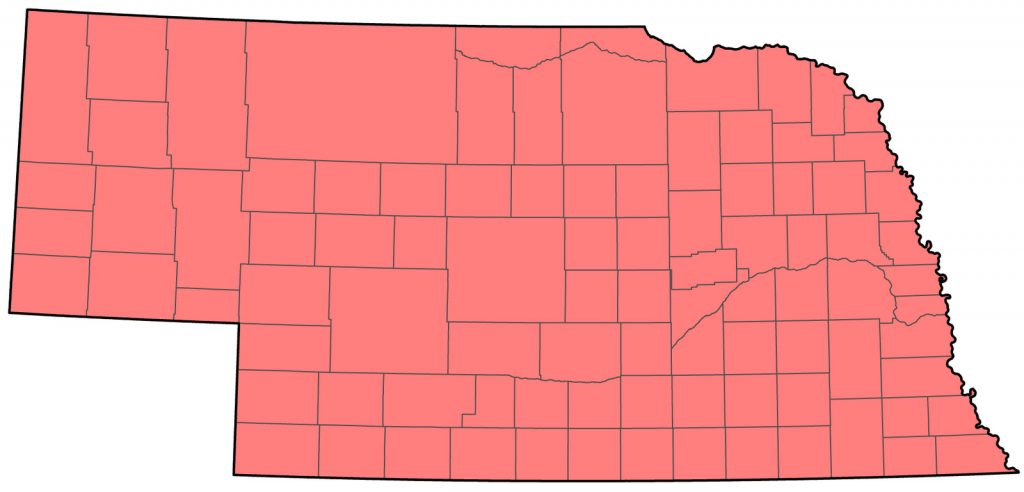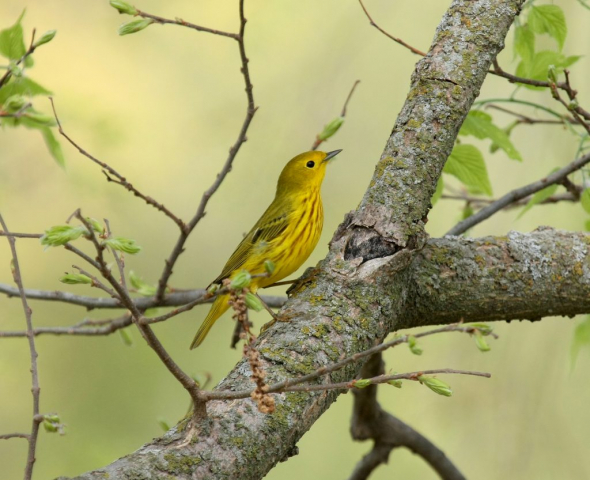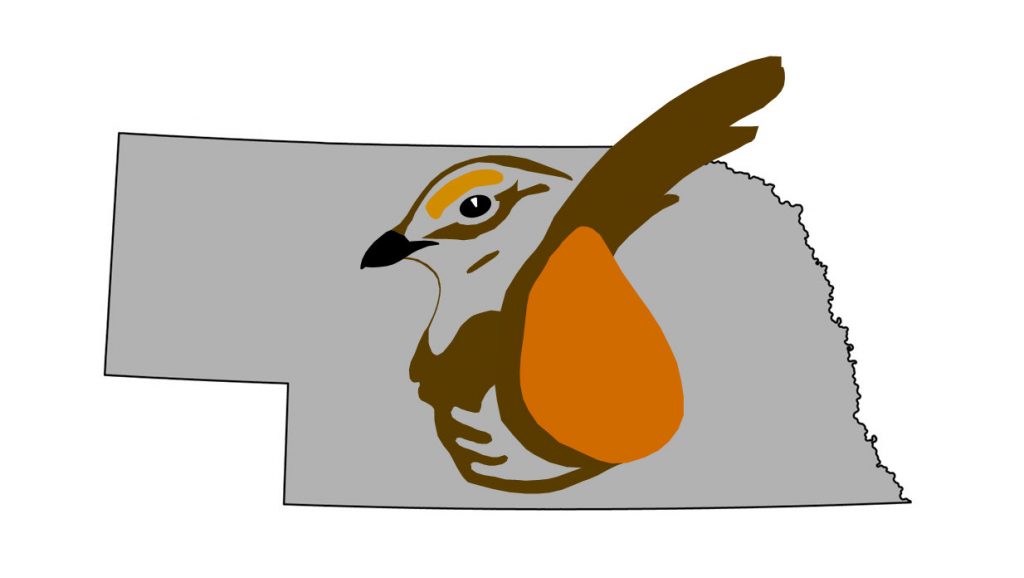Setophaga petechia aestiva, S. p. amnicola/parkesi
Status: Common regular breeder and spring and fall migrant statewide.

Documentation: Specimens: aestiva, UNSM ZM11952, 21 May 1895 Lancaster Co; parkesi/amnicola, UNSM ZM6823, 15 May 1901, Child’s Point, Sarpy Co (see Fig 1, below).
Taxonomy: Forty-three subspecies are recognized, in two groups, the temperate breeding group, American Yellow Warbler Setophaga aestiva, with nine subspecies, and the remaining 34 subspecies, essentially occurring south of the US, as Mangrove Warbler Setophaga petechia (AviList 2025).
AviList (2025) based its recognition of two species, American Yellow Warbler and Mangrove Warbler, on mitochondrial DNA evidence supported by differences in plumage, vocalizations, and ecology. A proposal (AOS 2018) to split Yellow Warbler into two species similar to the position taken by AviList and based on similar multiple lines of evidence failed.
The nine species in the northern migratory group (Browning 1994, AviList 2025) are rubiginosa, breeding in southern Alaska and coastal British Columbia, banksi breeding throughout most of central Alaska, parkesi breeding at the northern limits of the species’ distribution in northern Alaska, Northwest Territories, and northern Manitoba, amnicola, breeding south of parkesi from northwest British Columbia to Newfoundland and New Brunswick, aestiva, breeding south of amnicola and east of the Rocky Mountains from southern Alberta to Nova Scotia south to Oklahoma and North Carolina, morcomi, breeding from southern Yukon south through the interior of British Columbia through eastern Washington, eastern Oregon, eastern California east to western Montana, southern Wyoming, western Colorado, and northern Texas, brewsteri, breeding in coastal Washington, Oregon, and California, sonorana, breeding in Arizona and southern New Mexico south to northeastern Baja California Norte, interior Nayarit, and Zacatecas, and dugesi, breeding on the central plateau of Mexico.
Breeding birds in Nebraska are aestiva; this is the breeding subspecies of most of the USA east of the Rocky Mountains, including eastern Wyoming (Faulkner 2010). During migration, however, subspecies with darker plumage, noticeably on the forecrown and upperparts (Dunn and Garret 1997) may occur, including banksi, amnicola, and parkesi. Other than aestiva, only rubiginosa has been identified from Nebraska specimens; however, the three darker specimens we are aware of labelled rubiginosa at UNSM collected in May from 1901-1930 (UNSM ZM6823, cited above, UNSM ZM6824, and ZM10760) are likely assignable under current understanding to amnicola or parkesi since subspecies banksi is paler and more yellow on the forecrown; both are darker than aestiva with green crowns (Figure 1; Browning 1994, Dunn and Garrett 1997). These two northern subspecies migrate later in both spring and fall than aestiva.
A specimen in the Brooking Collection, #2683 taken 5 May 1920 at Inland, Clay Co was identified by Oberholser as rubiginosa, as were additional specimens collected in May (Swenk 1918).
The Rocky Mountain subspecies morcomi may occur as a migrant in the Panhandle; it is somewhat greener above and paler yellow below than aestiva (Dunn and Garrett 1997).

Spring: Apr 20, 20, 20 <<<>>> summer (except west); May 2, 2, 2 <<<>>> summer (west)
Earlier dates (except west) are 12 Apr 2010 Douglas Co, 17 Apr 2025 Lancaster Co, and 18 Apr 2025 Lancaster Co. An earlier date (west) was 30 Apr 2008 Scotts Bluff Co.
Migrants arrive in mid- to late Apr, somewhat later in the Panhandle, suggestive of the possibility that migrants there are largely northern birds of the races amnicola and parkesi or the Rocky Mountain race morcomi (see Taxonomy).
A study by Jorgensen and Brenner (2024) found that spring arrival dates had advanced by four days from 1938 to 2024.
- High counts: 186 in Hall Co 11 May 2002, 178 at Cunningham Lake, Douglas Co 10 May 2022, and 140 at Wilderness Park, Lancaster Co 11 May 2018, and in the west 85 at Crescent Lake NWR, Garden Co 28 May 1995, 58 at Chadron Reservoirs, Dawes Co 22 May 2023, 49 at Oliver Reservoir, Kimball Co 17 May 2025, and 49 at Sowbelly Canyon, Sioux Co 20 May 2025.
Summer: Yellow Warblers breed commonly statewide, usually associated with willows in riparian areas. Reports are fewest in the western Sandhills and the Panhandle away from the Pine Ridge and the North Platte River Valley (eBird.org, accessed Jan 2024; Mollhoff 2016). BBS data (Sauer et al 2020) show the species has increased 2.79% (95% C.I.; 1.27, 3.24) annually statewide during the period 1966-2019, although finer scale analysis shows declines of >1.5% in the southeast and western Sandhills (Sauer et al 2017).
- Breeding phenology:
Nest-building: 9 May-10 Jun
Eggs: 16 May- 17 Jul (Mollhoff 2022)
Nestlings: 18 May-1 Jul
Fledglings: 17 Jun-29 Jul
- High Counts: 43 along Pawnee Creek, Lincoln Co 27 Jun 2004, 43 at Wood Duck WMA, Stanton Co 18 Jun 2021, 40 near Gothenburg, Dawson Co 20 Jun 2017, 40 at Fort Kearny, Buffalo Co 21 Jun 2020, and 40 at Chadron Reservoirs, Dawes Co 24 Jun 2021.
Fall: summer <<<>>> Oct 8, 9, 9
Later dates are 22 Oct 2021 Wind Springs Ranch, Sioux Co, and a very late date 17 Nov 2013 Platte Co (Silcock 2013). Occasionally Yellow Warblers linger well into Dec north of the expected winter range; the only Dec-Feb records on the Great Plains north of Oklahoma are for Dec in Colorado: three in or near the Colorado Front Range and one in Pueblo Co, Colorado (eBird.org, accessed Jan 2024).
Departure from breeding grounds begins in mid-Jul, and migrants are generally gone by late Sep, although late dates are in Oct. Birds in Sep and later may be migrants of the darker-plumaged northern races amnicola and parkesi, as the breeding race aestiva leaves the breeding grounds early, starting in mid-Jul (Curson et al 1994); most Nebraska breeders may have departed by the end of Aug. Individuals of rubiginosa and amnicola do not arrive in Arizona until Oct (Lowther et al 2020).
Rosche (1994) noted that migrants in the Lake McConaughy area are most numerous in Aug, while information in Johnsgard (1980) suggests that peak fall migration is in late Aug and early Sep. Two birds were described as “certain migrants” in Clay Co 11 Aug, based on their location.
High counts: 71 at Rock Creek SRA, Dundy Co 9 Aug 2020, 70+ at Wind Springs Ranch, Sioux Co, 25 Aug 2001, 50 at Oliver Reservoir, Kimball Co 17 Aug 2024, and 43 at Lake Ogallala 26 Aug 2006.
Images
Abbreviations
BBS: Breeding Bird Survey
NWR: National Wildlife Refuge
SRA: State Recreation Area
UNSM: University of Nebraska State Museum
WMA: Wildlife Management Area (state)
Literature Cited
AOS. 2018. North and Middle America Classification Committee. Proposal Set 2018-C. Split Yellow Warbler (Setophaga petechia) into two species.
AviList Core Team, 2025. AviList: The Global Avian Checklist, v2025. https://doi.org/10.2173/avilist.v2025.
Browning, M. R. 1994. A taxonomic review of Dendroica petechia (Yellow Warbler; Aves: Parulinae). Proceedings of the Biological Society of Washington 107: 27-51.
Curson, J., D. Quinn, and D. Beadle. 1994. Warblers of the Americas. Houghton Mifflin Company, Boston, Massachusetts, USA.
Dunn, J.L., and K.L. Garrett. 1997. A field guide to warblers of North America. Houghton Mifflin Company, Boston, Massachusetts, USA.
Faulkner, D.W. 2010. Birds of Wyoming. Roberts and Company, Greenwood Village, Colorado, USA.
Johnsgard, P. A. 1980. A preliminary list of the birds of Nebraska and adjacent Great Plains states. Published by the author, University of Nebraska, Lincoln, USA.
Jorgensen, J.G., and S.J. Brenner. 2024. The changing spring migration patterns of selected bird species in Nebraska 1938-2024. Joint Report of the Nongame Bird Program at the Nebraska Game and Parks Commission and Audubon Great Plains, Lincoln, Nebraska, USA.
Lowther, P.E., C. Celada, N.K. Klein, C.C. Rimmer, and D.A. Spector. 2020. Yellow Warbler (Setophaga petechia), version 1.0. In Birds of the World (A. F. Poole and F. B. Gill, Editors). Cornell Lab of Ornithology, Ithaca, NY, USA. https://doi.org/10.2173/bow.yelwar.01.
Mollhoff, W.J. 2016. The Second Nebraska Breeding Bird Atlas. Bull. Univ. Nebraska State Museum Vol 29. University of Nebraska State Museum, Lincoln, Nebraska, USA.
Mollhoff, W.J. 2022. Nest records of Nebraska birds. Nebraska Ornithologists’ Union Occasional Paper Number 9.
Rosche, R.C. 1994. Birds of the Lake McConaughy area and the North Platte River valley, Nebraska. Published by the author, Chadron, Nebraska, USA.
Sauer, J.R., D.K. Niven, J.E. Hines, D.J. Ziolkowski, Jr, K.L. Pardieck, J.E. Fallon, and W.A. Link. 2017. The North American Breeding Bird Survey, Results and Analysis 1966 – 2015 (Nebraska). Version 2.07. USGS Patuxent Wildlife Research Center, Laurel, Maryland, USA.
Sauer, J.R., W.A. Link and J.E. Hines. 2020. The North American Breeding Bird Survey – Analysis Results 1966-2019. U.S. Geological Survey data release, https://doi.org/10.5066/P96A7675.
Silcock, W.R. 2013. Fall Field Report, August-November 2013. NBR 81: 134-160.
Swenk, M.H. 1918. Revisory notes on the birds of Nebraska. Wilson Bulletin 30: 112-117.
Recommended Citation
Silcock, W.R., and J.G. Jorgensen. 2025. Yellow Warbler (Setophaga petechia). In Birds of Nebraska — Online. www.BirdsofNebraska.org
Birds of Nebraska – Online
Updated 23 Jul 2025

